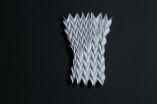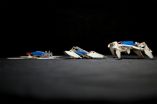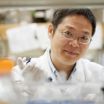(Press-News.org) Human tampering with global carbon balances has received massive public attention because of its effects on global warming, but we pay less attention to another set of chemical processes we are similarly disrupting: human input to the nitrogen cycle. Unfortunately, the story of nitrogen transformations in the biosphere is also less understood.
In modern times, humans developed the technology to turn nitrogen gas in the atmosphere into a biologically available form to be used as fertilizer. Before this, bio-available or "fixed" nitrogen was only created sparingly by natural forces such as lightning and nitrogen-fixing bacteria, while some fixed nitrogen was always being eliminated by denitrifying bacteria, which returned nitrogen to the atmosphere. This change to the planet's chemical balance has been critical because now the majority of life-essential nitrogen comes from human, not environmental, sources. Run-off from this systematic massive input of fixed nitrogen in managed natural and engineered environments (through agriculture and aquaculture), has lead to immediate problems like eutrophication in lakes and reservoirs and the oceans (with resulting dead zones), but also has long-term effects on the atmosphere.
Like carbon, nitrogen is naturally cycled and mediated in local ecosystems and integrated environmental processes by global cycling – facilitated by microbial communities. It has been well established that microbes take biologically usable nitrate (NO3 -) and process it in one of two critically important pathways – denitrification, which returns it to biologically inert nitrogen gas (N2,), or ammonification, which turns nitrate into ammonium (NH4+) and keeps the nitrogen biologically useable.
Because microbial ecosystems are vastly complex and difficult to monitor in nature, the environmental factors that determine whether microbial communities facilitate either the denitrification or the ammonification processes have been poorly understood. A variety of conditions -- including temperature, pH, the carbon to nitrogen ratio, and sulfide concentration -- have been suggested as potential determining elements but measurements taken directly from the environment have yielded conflicting or incomplete evidence.
Now, by performing 15 long-term experiments with a microbial community sampled from nitrate-filtering sediments found in a sandy tidal flat, researchers have been able to conclusively test the effect of controlled conditions and specific nutrient supplies on the fate of nitrate in nitrogen-cycling processes. The dynamics of structure and activity of the community were carefully monitored under controlled experimental conditions, using a suite of sophisticated bioinformatics techniques including metagenomics, transcriptomics and proteomics.
"I think our study differs in that we started with a really biodiverse sample that can do denitrification or ammonification and really let natural selection do its job," said Marc Strous, professor of geoscience at the University of Calgary and leader of the study. "We really get the best competitors in both pathways. This kind of study was not possible before the era of metagenomics because the whole system was simply too complex to study."
"The technology also allowed us to do continuous cultivation, where we are really able to mimic the conditions that occur in nature, but with the variables controlled," Strous noted.
The study will appear in the August 8 issue of Science. Strous' co-authors are Beate Kraft, Halinina E. Tegetmeyer, Timothy G. Ferdelman and Jeanine S. Geelhoed from the Max Planck Institute for Marine Microbiology, Ritin Sharma and Robert L. Hettich from the University of Tennessee-Oak Ridge National Lab Graduate School of Genome Science and Technology, and Martin G. Klotz, Department of Biological Sciences at the University of North Carolina at Charlotte.
The researchers found that three specific initial factors were conclusively responsible for determining the denitrification or ammonification of the nitrate supply, regardless of other conditions: the nitrite to nitrate ratio, the carbon to nitrogen ratio, and – hitherto unknown - the time it takes the microbes to duplicate themselves as a community (their "generation time"). Further, the team found that different specific cohorts of bacteria achieved system dominance to perform the processes, depending on the set conditions.
"The natural sample we used was from an area of sandy tidal flat, where nitrate flushes from fertilizer runoff pass through. The tides cause water movement through the sediments, so there is movement and disturbance and change," noted UNC Charlotte's Martin Klotz, an authority on microbial enzymes that process nitrogen. "Everything that survives there as a community has to be prepared for huge fluctuations. There are lots of little specialists that work together."
"There are very few micro-organisms that have in one cell all the tools to do either complete direction of these reactions," Klotz said. "It is usually different populations that translate to these bins that do one or the other and they are favored by environmental signals. Either there is energy and reductant available for them to make a living or they respond to different cues, such as pH, temperature, and so on. "
Strous notes that it really comes down to the basic chemical pathways and their energetics, which, depending on conditions, allow different assemblages of bacteria to work together and do their part in the process. The three factors identified by Strous' team's experiments are the critical switches that determine whether it is the denitrification or the ammonification process that dominates the microbial ecosystem, in that the factors select specific bacteria that succeed in getting major parts in the process.
"The factors we found that drive the processes are very generic," Strous said. "The findings imply that these can be applied to any ecosystem. It's really a generalizable result because the factors seem to act directly on the basic pathways."
Among the three factors the experiment identified as being critical in determining the process, the ratio of the two oxidized forms of fixed nitrogen, nitrate (NO3-) or nitrite (NO2-), is the most basic because when nitrite is more abundant (nitrate can change to nitrite and vice-versa), the process that dominates is inevitably denitrification.
"Nitrite accepts three electrons in denitrification and six in ammonification," Strous pointed out. "In both cases, the supply is there, but the difference between the way the denitrifiers respire them is that out of each electron accepted they are able to conserve more of the energy – less energy gets lost as heat, per electron."
When nitrite is more abundant, the denitrifying bacteria dominate because they are more efficient and faster. The fundamental advantage of the speed and efficiency of the denitrification process also contributes in part to the second critical factor the study found – microbial generation time. Regardless of the ratio of the fixed nitrogen supply, when conditions encouraged rapid regeneration (generation time of less than 1.7 days), then the denitrifying bacterial groups came to dominate (either rapidly or eventually), but slow growth conditions favored ammonifying bacteria.
The same kind of fundamental chemical energy reasoning seems to help explain the third critical factor the team identified – the carbon to nitrogen ratio.
"As has already been proposed in the literature, the carbon to nitrogen ratio is an important factor because, based on the bioenergetics, carbon limitation will favor denitrification – denitrifying organisms will have higher productivity under those conditions. Whereas the ammonifying microorganisms will have higher productivity when the nitrogen is limited. That follows from the way these organisms respire these compounds," Strous said.
"Carbon limited means that these organisms have less to eat. You need carbon for making biomass," Klotz added. "A good portion of these guys are fermenters and they produce products that serve others as reductant and energy sources – hydrogen, formate, acetate. If that is not happening because the carbon is low, then only the fast and cheap will prevail, which perform predominantly denitrification."
Though the findings are fundamental, Strous and Klotz both stress that gaining a more conclusive understanding of dynamics of the microbial systems in the environment that process the new, human-caused abundance of fixed nitrogen has important implications.
"When you look at the coastal systems we studied," Strous said, "those are actually fairly important in terms of getting rid of the nutrients in Europe.
"We understand this better now and this understanding is not trivial because the outcome of this competition is really important in determining primary productivity -- because ammonium from ammonification is directly re-usable by the primary producers and with denitrification the nitrogen is mainly lost. So this hard-to-study bacterial competition is really important in determining that primary productivity. In any modeling you do on how human impact causes global change, this is a very important piece of the puzzle."
Klotz stresses how the study shows the importance of having new "omics" tools – metagenomics, transcriptomics, proteomics, etc. – to help study in real time the metabolic activity and changes going on in complex bacterial communities.
"We looked for what genes were being expressed, what proteins were there and we could correlate and assign inventory to lifestyles of organisms. We had taxonomic markers because we could assign N-cycle relevant genes to known genomes, so we knew who we could attribute the processes to," he noted.
"What was most interesting for me is I could localize in different taxonomic branches the different enzymes that participate at the different conditions," Klotz said. "I could distinguish between enzymes that are known to be involved in these processes. We could watch how a microbial ecosystem's biochemical modules compete under real conditions."
James Hathaway, 704-687-5743
jbhathaw@uncc.edu
Sources:
Marc Strous, University of Calgary, 403-220-6604
mstrous@ucalgary.ca
Martin Klotz, UNC Charlotte, 704-687-5468, 502-296-7817
mklotz@uncc.edu
INFORMATION:
Study reveals dynamics of microbes and nitrate
2014-08-07
ELSE PRESS RELEASES FROM THIS DATE:
Origami could lead to exotic materials, tiny transformers
2014-08-07
ITHACA, N.Y. – Embracing the pleats, creases and tucks of the Japanese art of decorative paper folding, Cornell University researchers are uncovering how origami principles could lead to exotic materials, soft robots and even tiny transformers.
Publishing online in the journal Science Aug. 8, an interdisciplinary team led by Cornell's Itai Cohen, associate professor of physics, and graduate student Jesse Silverberg have discovered how to use a well-known origami folding pattern called the Miura-ori to control fundamental physical properties of any thin sheet of material.
Video, ...
Step closer to birth of the sun
2014-08-07
Researchers are a step closer to understanding the birth of the sun.
Published in Science, the team led by Dr Maria Lugaro and Professor Alexander Heger, from Monash University, have investigated the solar system's prehistoric phase and the events that led to the birth of the sun.
Dr Lugaro, from the Monash Centre for Astrophysics, said the team used radioactivity to date the last time that heavy elements such as gold, silver, platinum, lead and rare-earth elements were added to the solar system matter by the stars that produced them.
"Using heavy radioactive nuclei ...
Finding the genetic culprits that drive antibiotic resistance
2014-08-07
Researchers have developed a powerful new tool to identify genetic changes in disease-causing bacteria that are responsible for antibiotic resistance. The results from this technique could be used in clinics within the next decade to decide on the most effective treatments for diseases such as pneumonia and meningitis.
The team looked at the genome of Streptococcus pneumoniae, a bacterial species that causes 1.6 million deaths worldwide each year. In the most detailed research of its kind, scientists used a genome-wide association study (GWAS) to locate single-letter ...
Learning from origami to design new materials
2014-08-07
AMHERST, Mass. -- A challenge increasingly important to physicists and materials scientists in recent years has been how to design controllable new materials that exhibit desired physical properties rather than relying on those properties to emerge naturally, says University of Massachusetts Amherst physicist Christian Santangelo.
Now he and physicist Arthur Evans and polymer scientist Ryan Hayward at UMass Amherst, with others at Cornell and Western New England University, are using origami-based folding methods for "tuning" the fundamental physical properties of any ...
Robot folds itself up and walks away
2014-08-07
A team of engineers used little more than paper and Shrinky dinks™ – the classic children's toy that shrinks when heated – to build a robot that assembles itself into a complex shape in four minutes flat, and crawls away without any human intervention. The advance, described in Science, demonstrates the potential to quickly and cheaply build sophisticated machines that interact with the environment, and to automate much of the design and assembly process. The method draws inspiration from self-assembly in nature, such as the way linear sequences of amino acids fold into ...
Origami robot folds itself up, crawls away
2014-08-07
For years, a team of researchers at MIT and Harvard University has been working on origami robots — reconfigurable robots that would be able to fold themselves into arbitrary shapes.
In the August 7 issue of Science, they report their latest milestone: a robot, made almost entirely from parts produced by a laser cutter, that folds itself up and crawls away as soon as batteries are attached to it.
"The exciting thing here is that you create this device that has computation embedded in the flat, printed version," says Daniela Rus, the Andrew and Erna Viterbi Professor ...
NASA sees heavy rainfall in Iselle as the hurricane nears Hawaii
2014-08-07
VIDEO:
TRMM satellite rainfall data overlaid on an enhanced infrared image from NOAA's GOES-West satellite shows heavy rainfall occurring around the Iselle's eye. The most intense rain was falling at a...
Click here for more information.
A NASA satellite has observed heavy rainfall in Hurricane Iselle on its approach to Hawaii. NASA's TRMM Satellite captured rainfall rates within the storm as it passed overhead. In addition, NASA's Aqua satellite provided a larger view of the Central ...
Cell signaling pathway linked to obesity, type 2 diabetes
2014-08-07
WEST LAFAYETTE, Ind. - A Purdue University study shows that Notch signaling, a key biological pathway tied to development and cell communication, also plays an important role in the onset of obesity and Type 2 diabetes, a discovery that offers new targets for treatment.
A research team led by Shihuan Kuang, associate professor of animal sciences, found that blocking Notch signaling in the fat tissue of mice caused white fat cells to transform into a "leaner" type of fat known as beige fat. The finding suggests that suppressing Notch signaling in fat cells could reduce ...
Gut microbes browse along a gene buffet
2014-08-07
DURHAM, N.C. -- In the moist, dark microbial rainforest of the intestine, hundreds of species of microorganisms interact with each other and with the cells of the host animal to get the resources they need to survive and thrive.
Though there's a lot of competition in this vibrant ecosystem, collaboration is valued too. A new study on the crosstalk between microbes and cells lining the gut of mice shows just how cooperative this environment can be.
One of the main ways that hosts manage their interactions with microbes is by carefully controlling the genes that their ...
NASA sees Hurricane Julio organize and emit a gamma-ray flash
2014-08-07
NASA's Fermi and Aqua satellites captured two different views of bursts of strength show by Hurricane Julio as it intensified. NASA's Fermi satellite saw a gamma-ray flash from Julio, while NASA's Aqua satellite saw Julio become more structurally organized as a hurricane.
This type of outburst is known as a terrestrial gamma-ray flash (TGF). Produced by the powerful electric fields in thunderstorms, TGFs last only a few thousandths of a second but emit gamma rays that make up the highest-energy naturally-occurring light on Earth. Scientists estimate that, on average, ...




